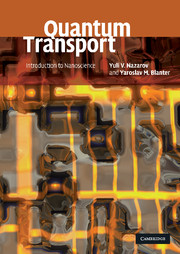Book contents
- Frontmatter
- Contents
- Preface
- Introduction
- 1 Scattering
- 2 Classical and semiclassical transport
- 3 Coulomb blockade
- 4 Randomness and interference
- 5 Qubits and quantum dots
- 6 Interaction, relaxation, and decoherence
- Appendix A Survival kit for advanced quantum mechanics
- Appendix B Survival kit for superconductivity
- Appendix C Unit conversion
- References
- Index
5 - Qubits and quantum dots
Published online by Cambridge University Press: 05 June 2012
- Frontmatter
- Contents
- Preface
- Introduction
- 1 Scattering
- 2 Classical and semiclassical transport
- 3 Coulomb blockade
- 4 Randomness and interference
- 5 Qubits and quantum dots
- 6 Interaction, relaxation, and decoherence
- Appendix A Survival kit for advanced quantum mechanics
- Appendix B Survival kit for superconductivity
- Appendix C Unit conversion
- References
- Index
Summary
It is difficult nowadays to graduate from a department of natural sciences and not hear anything about quantum computing, most likely about the fascinating prospects of it. Quantum computing by its origin is a rather abstract discipline, a branch of math or information science. It has emerged from a persistent search for more efficient ways to process information when quantum mechanics made it to the scope of the search. Being an abstract discipline, quantum computing approximates a physical quantum system with a number of axioms and explores the consequences of these axioms, precisely as conventional math has been. These activities begun in the 1970s, and for a long time it was not obvious why quantum calculational schemes have to be any better than common computer algorithms. This extensive work was rewarded with a break-through in 1994, when Peter Shor discovered a remarkable quantum algorithm for the factorization of large numbers into prime ones. This sounds quite abstract, but many public key cryptosystems will become obsolete if Shor's algorithm is ever implemented in a practical quantum computer. Modern communication security is based on the fact that the factorization is a tough problem for a classical computer: it takes too long to crack a code. The proposed algorithm speeds up the factorization enormously. The discovery by Shor has brought quantum computing to the scientific and even public attention.
This progress has motivated a massive research effort towards the manipulation of individual quantum systems, the practical realization of quantum computing schemes being one of the most attractive goals. This chapter describes this goal, the quantum transport systems suitable for it, and the achievements made so far.
- Type
- Chapter
- Information
- Quantum TransportIntroduction to Nanoscience, pp. 374 - 456Publisher: Cambridge University PressPrint publication year: 2009



